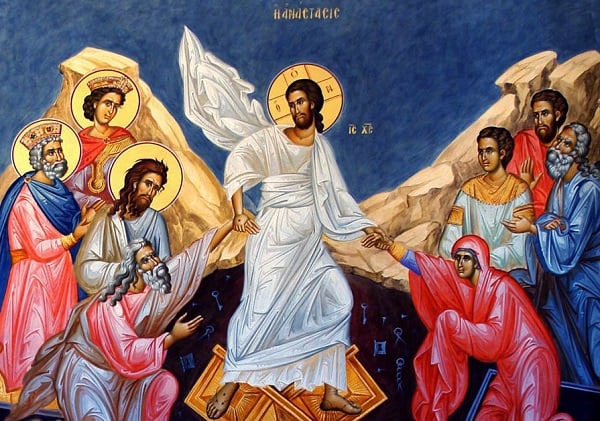The Time, Location and Purpose of Christ’s Descent into Hades, according to Biblical and Patristic Tradition
19 April 2020The time of the descent.
As regards the time of the descent, we can see that Christ’s divine soul descended into Hades immediately after His exclamation on the Cross ‘It is finished’, when His soul was separated from His all-pure body. He remained there three days, until the Resurrection, a period during which His body lay without breath or decay in the tomb. This was from the evening of Friday to the morning of Sunday (See Matth., 12, 40; Acts 2, 31 and 13, 37; Ps. 15, 10; Luke 23, 43; John 20, 17; I Peter, 3, 19 etc.). This is why the Orthodox Church declared that the descent was to be celebrated on Great Saturday. The synaxari for the day reads: ‘On Holy and Great Saturday, we celebrate the burial of the divine body of our Lord and Savior Jesus Christ and His descent into Hades, through which our race was recalled from corruption and crossed into eternal life’. In the services of the Passion and Resurrection, the descent is the subject of many hymns. On Great Friday, the descent is mentioned more than fifty times and in the services of the Pentecostario more than two hundred.

One such hymn is:
Lord, when you were raised upon the cross, you expunged our ancestral curse; and descending into Hades you broke the ancient bonds, giving incorruption to the human race. Therefore in hymns we glorify your life-giving and saving resurrection’.
The location of the descent
Regarding the location of Hades, where the Savior descended, Holy Scripture does not provide us with specifics. For this reason, the Church Fathers and writers have made a number of suggestions. The most common is that Hades is an underground place, below the surface of the earth, within it, perhaps at its core. The Apostles Paul and John appear to extend Hades to include what is ‘in the heavens’ (Eph. 2, 2; 6, 12) and ‘on the earth and below the earth (Rev. 5, 13), taking in the three orders of those ‘in heaven, on earth and under the earth’ (Phil. 2, 10). Hades is understood not only as a condition, but as an actual location in which the good and the bad dwell. It is divided into two parts which are different and are separated by a yawning chasm, of unknown nature: there is the place of respite and the place of pain. (Luke 16, 22-26). The Redeemer descended into both these ‘locations’ and preached the Gospel of salvation to the souls who were there. In the New Testament, the place of respite is called ‘the bosom of Abraham (Luke 16, 22) and ‘paradise’ (Luke 23, 43); while the place of pain is known as ‘Hades’ (Luke 16, 23), ‘a place of torment’ (Luke 16, 28), a ‘prison’ (I Peter, 3, 19), and an ‘abyss’ (Rom. 10, 7). Even from the time of the Early Church, it was believed, according to Justin Martyr, that ‘the souls of the righteous dwelt in a better place and the souls of the unrighteous and wicked in a worse place, awaiting the time of the judgment’.
It should be said that the problem of the location of Hades is only of relative importance in Orthodox theology. After death, the souls of the departed are bodiless, so it is a waste of time to try to discover their dwelling place and even more so to try and describe it, since a bodiless soul is not confined to a particular location. Hell, therefore is a condition, rather than a specific location.
The purpose of the risen Redeemer in descending into Hades.
Christ’s task in Hades was the continuation and completion of His redemptive work through the extension and transmission of salvation to the souls od the departed, to whom He preached the Gospel of salvation. The Savior entered ‘as God and Lord’ and ‘preached to the imprisoned spirits’ (I Peter, 3, 19; Matth. 12, 40) the Gospel of salvation. He brought to them God’s grace and offered them all the chance of salvation, though not all accepted it.
Since it was not fair, nor kind nor good for salvation to be limited only to people who were alive at that time, but ought to include the souls of the departed who were dwelling in Hades, in accordance with the absolute and universal character of the Christian religion, this is what the Redeemer did in Hades. This is why the Church sings:
‘When Christ descended to those dwelling in Hades, he took the joyous message, saying: Be of good courage. I have overcome. I am the resurrection, I will raise you, destroying the gates of death’.
Christ’s task in Hades was completed with His resurrection, through which He fulfilled the whole of His work of redemption. This is why the Orthodox see in Christ’s resurrection the main pledge of salvation, the final victory over and destruction of the state of sin, corruption and death. It is the promise and beginning of the resurrection and immortality of all people.
Finally, the redemptive work of the Redeemer extended to the whole of creation, which regained its initial purpose after it had fallen because of humankind. The whole of creation, visible and invisible, blesses, hymns and glorifies the Creator, participating in a mysterious manner in Christ’s death on the Cross and His descent into Hades. This is why the Orthodox Church invites creation and the whole world to the festal celebration of the glorious Resurrection of the Savior.
‘Let the heavens rejoice, let the earth be glad, let visible and invisible creation celebrate. For Christ has risen, Who is eternal joy’.






